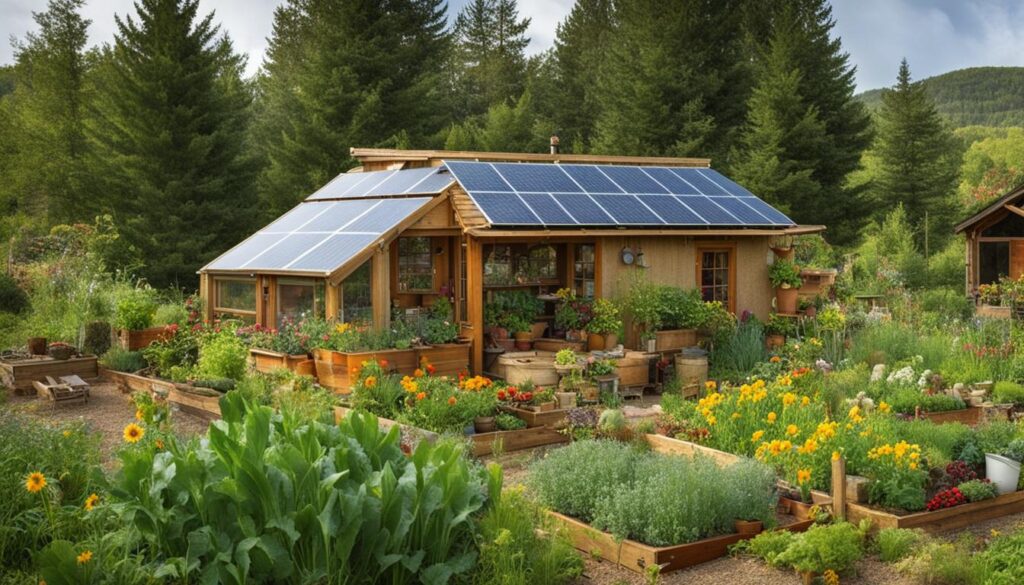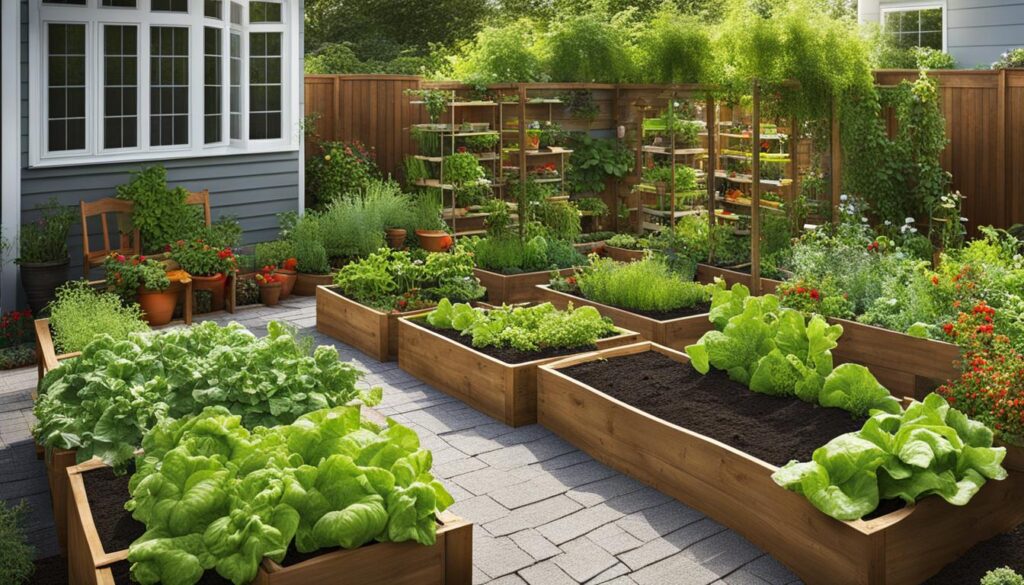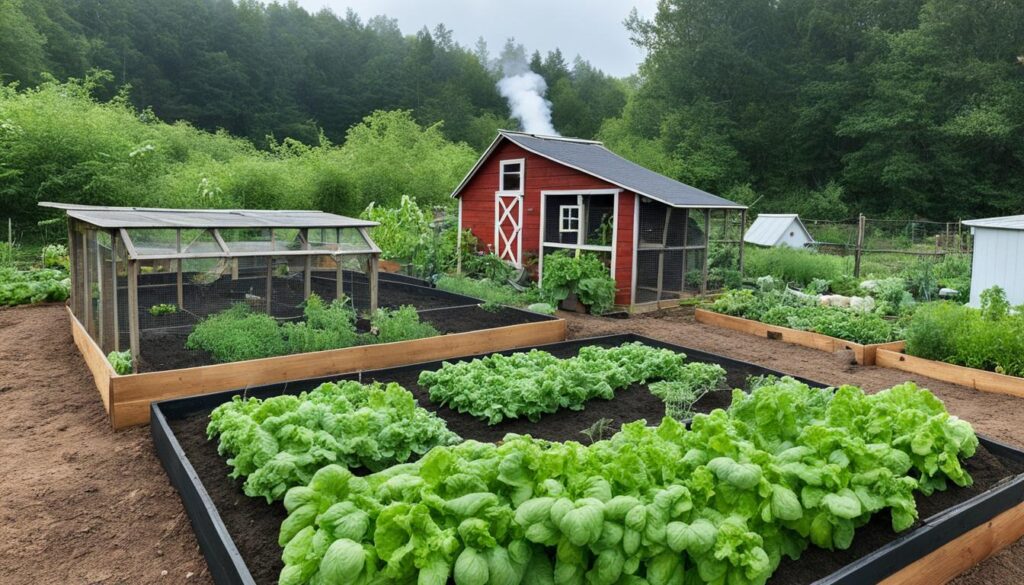
Greetings! If you’re eager to embark on a self-sufficient and sustainable lifestyle, homesteading might be just the journey for you. Whether you live in a sprawling rural area or a cozy urban apartment, you can start your homesteading adventure and enjoy the rewards of a simplified and eco-friendly existence.
Homesteading encompasses a wide range of activities aimed at reducing dependence on external sources and embracing a more self-sufficient way of life. From growing your own food to raising animals, homesteading allows you to reconnect with nature and acquire valuable skills like woodworking, sewing, and much more.
In this beginner’s guide, I will walk you through the essentials of starting your homesteading journey. From tips on self-sufficiency and sustainable living to off-grid survival skills, this guide will provide you with the necessary knowledge to kickstart your prepper journey.
Key Takeaways:
- Homesteading is a lifestyle centered around self-sufficiency and sustainable living.
- It can be practiced in both rural and urban settings, with activities such as growing food, raising animals, and learning various skills.
- Starting a homestead offers benefits like reduced reliance on outside sources and a closer connection to nature.
- Planning, acquiring skills, and finding suitable land are key steps in starting your homesteading journey.
- Homesteading activities include subsistence agriculture, food preservation, craft production, and off-grid living.
What is a Homestead and Why Should You Start Homesteading?
A homestead is a place where individuals or families strive to live a self-sufficient lifestyle. It encompasses various activities such as small-scale farming, sustainable living techniques, and reducing dependence on external sources. While commonly associated with rural farms, homesteading can also be embraced in urban settings through practices like urban agriculture and utilizing small spaces efficiently.
By starting a homestead, you can experience the benefits of a self-sufficient lifestyle. You can enhance your self-sufficiency by producing your own food, reducing reliance on supermarkets, and embracing sustainable living techniques. Developing a homestead allows you to connect with nature and cultivate a closer relationship with the environment. Additionally, a homesteading lifestyle promotes frugality and sustainability, leading to a more fulfilling and purposeful existence.
Whether you have access to vast land or reside in a small urban apartment, homesteading can be adapted to your unique circumstances. By incorporating self-sufficient practices into your everyday life, you can create a more sustainable future for yourself and the planet.
| Benefits of Homesteading | Why Start Homesteading? |
|---|---|
| 1. Self-Sufficiency: | Embrace a self-sufficient lifestyle and reduce reliance on external sources for food, resources, and amenities. |
| 2. Connection to Nature: | Establish a deeper bond with the environment and foster a greater appreciation for the natural world. |
| 3. Frugal Living: | Save money by producing your own food, utilizing sustainable alternatives, and minimizing unnecessary expenses. |
| 4. Sustainability: | Reduce your ecological footprint and contribute to a more sustainable future for yourself and future generations. |
| 5. Personal Fulfillment: | Enjoy a sense of purpose, fulfillment, and accomplishment by creating a self-sufficient and sustainable lifestyle. |
How to Start a Homestead – Step by Step
Starting a homestead is an exciting journey that requires careful planning, goal-setting, acquiring skills, and preparing the land. Here’s a step-by-step guide to help you get started:
- Define Your Vision: Take some time to consider what homesteading means to you and what your goals and priorities are. Determine whether you want to live on or off the grid, raise animals, or focus on self-sufficient farming. This will help you create a clear vision for your homestead.
- Set Goals: Once you have a vision, set specific and achievable goals that align with it. This could include goals related to food production, energy independence, or skill acquisition. Setting goals will keep you motivated and help you stay focused on your long-term vision.
- Acquire Skills: Homesteading requires a diverse set of skills. Start by acquiring skills that are relevant to your goals and interests. This could include learning about gardening, food preservation techniques, woodworking, animal husbandry, or even off-grid living practices. Take advantage of online resources, workshops, and local homesteading communities to acquire the necessary knowledge and skills.
- Research and Prepare Land: Finding and preparing suitable land is essential for your homestead. Research available land options in your desired location, considering factors such as size, soil quality, water access, and zoning regulations. Assess the suitability of the land for your planned activities, such as gardening or raising animals. Take time to prepare the land by clearing, leveling, and building necessary infrastructure like fencing or irrigation systems.
“Starting a homestead is a gradual process that requires careful planning and acquiring the necessary skills. It’s important to have a clear vision, set achievable goals, and prepare the land for your desired activities.”
To provide a visual representation of the step-by-step process, here’s a table outlining the key steps to start a homestead:
| Steps to Start a Homestead |
|---|
| 1. Define Your Vision |
| 2. Set Goals |
| 3. Acquire Skills |
| 4. Research and Prepare Land |
By following these steps, you’ll be well-prepared to start your homesteading journey and create a sustainable and self-sufficient lifestyle.
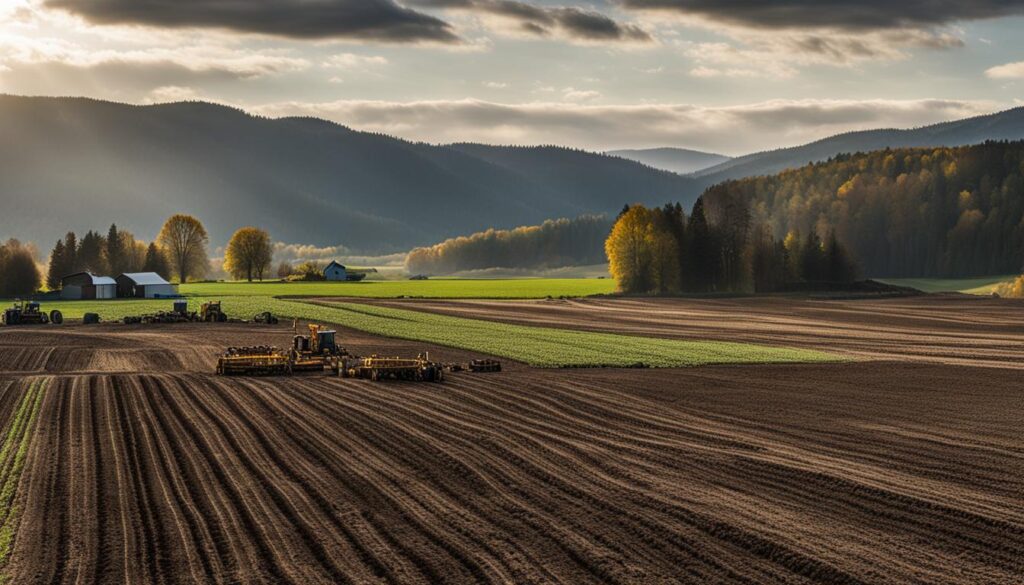
Common Homesteading Activities
Homesteading activities vary depending on individual preferences and circumstances. As a homesteader, I engage in a variety of activities that promote self-sufficiency, sustainability, and a simpler way of life.
Subsistence Agriculture
One of the fundamental aspects of homesteading is subsistence agriculture. By growing my own food, I reduce my dependence on grocery stores and have the satisfaction of knowing exactly where my food comes from. In my garden, I cultivate a diverse range of fruits, vegetables, and herbs, ensuring a fresh and nutritious supply throughout the year.
Food Preservation
Food preservation techniques are essential skills for homesteaders. Canning and drying fresh produce allow me to enjoy the flavors of summer all year round. I carefully preserve vegetables, fruits, and even homemade sauces and jams for nutritious and delicious meals during the winter months.
Craft Production
Homesteading offers the opportunity to embrace my creativity and engage in craft production. I enjoy making my own clothing, textiles, and household items using traditional techniques such as sewing, knitting, and weaving. This not only allows me to reduce waste but also creates a connection to the past and a sense of self-reliance.
Off-Grid Living
Embracing off-grid living is a significant aspect of my homesteading lifestyle. I rely on renewable energy sources such as solar panels and wind turbines to power my home, reducing my environmental impact and living more sustainably. Being off-grid also means I am less reliant on external utilities, giving me greater control over my energy consumption.
These are just a few examples of the common activities that homesteaders like myself engage in. Through subsistence agriculture, food preservation, craft production, and off-grid living, I am able to lead a more self-sufficient and sustainable life.
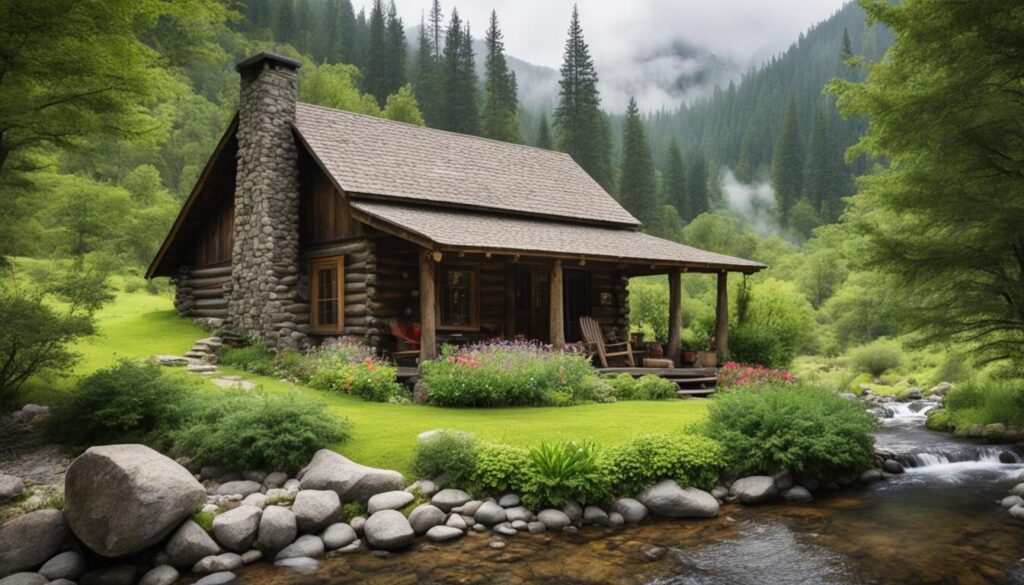
How to Find Land for a Homestead
Finding the right land for a homestead is an essential step in starting your journey to a self-sufficient lifestyle. Whether you prefer a rural or urban setting, selecting the perfect piece of land requires careful consideration. Here are some factors to keep in mind:
Land Suitability
Determine if the land is suitable for your desired homesteading activities. Assess factors such as soil quality, climate, and topography to ensure optimal conditions for gardening, raising animals, and practicing other self-sufficient skills.
Water Access
Water is vital for irrigation, livestock, and daily use. Look for land with reliable access to freshwater sources, such as rivers, lakes, or wells. A sustainable water supply is crucial for a successful homestead.
Rural vs Urban Homesteading
Consider whether you prefer a rural or urban homesteading experience. Rural areas offer larger plots of land, abundant natural resources, and room for expansive farming. Conversely, urban homesteading requires creative space utilization and compliance with local regulations.
Community Support
Investigate the availability of community support in the chosen location. Access to nearby homesteading communities, farmer’s markets, and local resources can enhance your homesteading experience and provide valuable guidance and assistance.
Research and assess potential properties thoroughly before making a purchase. Take into account all relevant factors to ensure your homestead meets your needs and supports your desired self-sufficient lifestyle.
Remember, finding the right land is like laying the foundation for your homesteading dream. Take your time, explore different options, and make an informed decision that aligns with your goals and preferences.
What is the History of Homesteading?
The history of homesteading is deeply intertwined with various movements throughout history. One prominent era in the United States was the homesteading movement, which gained popularity in the 19th and early 20th centuries. This movement was fueled by the passage of the Homestead Act, which allowed individuals to claim and develop public land. Through this act, people could establish homesteads and create a life centered around self-sufficiency and the cultivation of their own land.
In more recent history, the back-to-the-land movement of the 1960s and 1970s brought attention to the idea of self-sufficiency and simplicity. During this time, individuals and families sought to disconnect from mainstream society and embrace a more sustainable lifestyle. Homesteading became a means of living off the land, growing food, and relying on one’s own resources.
Today, homesteading continues to captivate individuals and families who are drawn to the principles of self-sufficiency and simplicity. The desire for a more sustainable and fulfilling lifestyle drives many to embrace homesteading as a way to reconnect with nature, reduce their environmental impact, and find a sense of purpose in cultivating their own food, raising animals, and practicing various skills. By embracing the history and ideals of homesteading, individuals are forging their own path towards a more sustainable and fulfilling life.
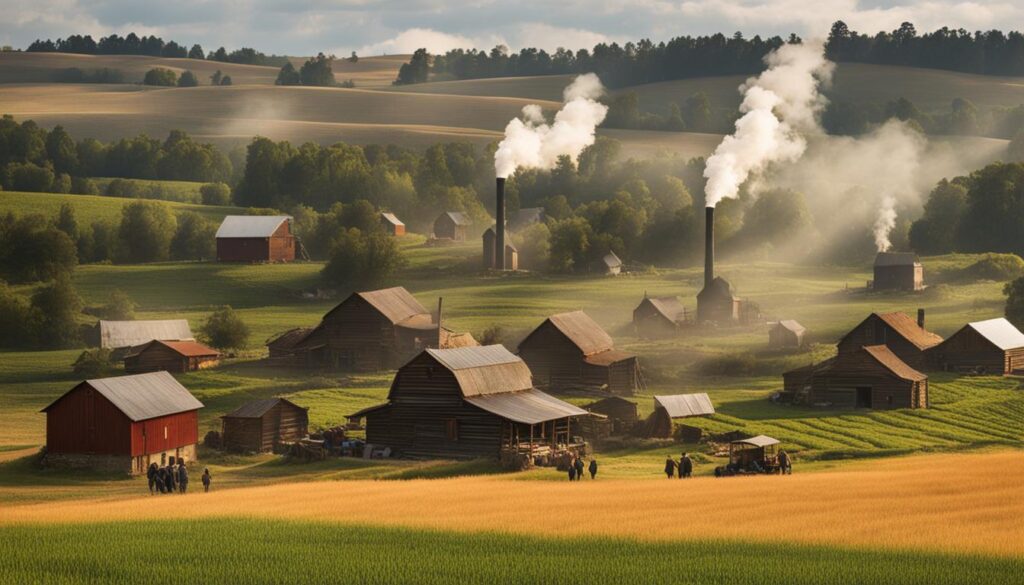
Can I Get Free Land Through Homesteading?
While the concept of free land through homesteading may sound appealing, it’s important to note that the Homestead Act, which allowed individuals to claim free land, was repealed in 1976. However, there are still government programs and initiatives that support homesteading and provide opportunities for acquiring land at discounted prices or with certain incentives.
These programs vary by location and have specific requirements and eligibility criteria. It’s important to research and explore available options in your area if you’re interested in acquiring land for your homestead.
Conclusion
Embarking on a homesteading journey can be a fulfilling and rewarding experience. Whether you’re starting small with a backyard garden or diving into a full-scale farm, the homesteading lifestyle offers opportunities to live more self-sufficiently, reduce your environmental impact, and connect with nature.
With careful planning, acquiring necessary skills, and finding suitable land, you can begin your homesteading journey and enjoy the benefits of a simplified and sustainable lifestyle. Homesteading is a personal journey, so take the time to create a vision and set goals that align with your values and aspirations.
Remember, the homesteading lifestyle is not just about growing your own food and living off the land. It encompasses a mindset of self-sufficiency and sustainability, fostering a deeper connection with the natural world. By starting your homesteading journey, you can create a life that is more in tune with your values, while also making a positive impact on the environment.
FAQ
What is homesteading?
Homesteading is a lifestyle centered around self-sufficiency and sustainable living. It involves activities such as growing food, raising animals, and practicing various skills like sewing and carpentry to reduce reliance on outside sources and live closer to nature.
Where can homesteading be practiced?
Homesteading can be practiced in both rural and urban settings. While traditionally associated with rural farms, it can also be practiced in urban settings through sustainable living techniques and urban agriculture.
How do I start a homestead?
The first step is to consider your goals and priorities for homesteading. Determine if you want to live on or off the grid, raise animals, or focus on self-sufficient farming. Acquiring the necessary skills, finding suitable land, and preparing it for your desired activities are also important steps.
What are common homesteading activities?
Common homesteading activities include subsistence agriculture, food preservation techniques like canning and drying, craft production, off-grid living, and practicing sustainable living techniques.
How can I find land for a homestead?
When searching for land, consider factors such as land suitability, access to water sources, and community support. Thoroughly research and assess potential properties before making a purchase. Rural homesteaders may need to travel longer distances for supplies and services, while urban homesteaders may face challenges related to space limitations and local regulations.
What is the history of homesteading?
Homesteading gained popularity in the 19th and early 20th centuries in the United States with the passage of the Homestead Act. The back-to-the-land movement of the 1960s and 1970s also brought attention to self-sufficiency and simplicity.
Can I get free land through homesteading?
The Homestead Act, which allowed individuals to claim free land, was repealed in 1976. However, there are still government programs and initiatives that support homesteading and provide opportunities for acquiring land at discounted prices or with certain incentives. Eligibility and requirements vary by location.
What are the benefits of starting a homestead?
Starting a homestead allows you to live a more self-sufficient and sustainable lifestyle, reduce your environmental impact, and connect with nature. It also provides opportunities for increased frugality and a closer connection to the food you consume.

